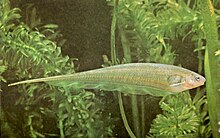Eigenmannia
| Eigenmannia | |
|---|---|

| |
| Eigenmannia virescens | |
| Scientific classification | |
| Kingdom: | |
| Phylum: | |
| Class: | |
| Order: | |
| Family: | |
| Genus: | Eigenmannia D. S. Jordan & Evermann, 1896
|
| Type species | |
| Sternopygus humboldtii Steindachner, 1878
| |
Eigenmannia is a genus of fish in the family Sternopygidae (glass knifefishes) native to tropical and subtropical South America (south to the Río de la Plata Basin), and Panama.[1][2] They are typically found in slow-flowing streams, along the edge of large rivers, in deep river channels and in floodplains, and the genus also includes E. vicentespelaea, the only cave-adapted knifefish.[2][3] Eigenmannia are often found near submerged roots, aquatic plants and floating meadows.[3][4]
Depending on the exact species, they have a maximum total length of 14.3–49.6 cm (6–20 in).[1] They are nocturnal, and feed on small invertebrates such as aquatic insect larvae and zooplanktonic crustaceans.[3]
Species
There are currently 23 recognized species in this genus:[1][5]
- Eigenmannia antonioi L. A. W. Peixoto, Dutra & Wosiacki, 2015[2]
- Eigenmannia besouro L. A. W. Peixoto & Wosiacki, 2016[6]
- Eigenmannia correntes Campos-da-Paz & Queiroz, 2017[7]
- Eigenmannia desantanai L. A. W. Peixoto, Dutra & Wosiacki, 2015[2]
- Eigenmannia goajira L. P. Schultz, 1949[8]
- Eigenmannia guairaca L. A. W. Peixoto, Dutra & Wosiacki, 2015[2]
- Eigenmannia humboldtii (Steindachner, 1878)
- Eigenmannia limbata (Schreiner & A. Miranda-Ribeiro, 1903)
- Eigenmannia loretana Waltz & Albert, 2018[9]
- Eigenmannia macrops (Boulenger, 1897)
- Eigenmannia matintapereira L. A. W. Peixoto, Dutra & Wosiacki, 2015[2]
- Eigenmannia meeki Dutra, de Santana & Wosiacki, 2017[10]
- Eigenmannia microstoma (J. T. Reinhardt, 1852)
- Eigenmannia muirapinima L. A. W. Peixoto, Dutra & Wosiacki, 2015[2]
- Eigenmannia nigra Mago-Leccia, 1994
- Eigenmannia oradens Dutra, Peixoto, de Santana & Wosiacki, 2018[11]
- Eigenmannia pavulagem L. A. W. Peixoto, Dutra & Wosiacki, 2015[2]
- Eigenmannia sayona Peixoto & Waltz, 2017[12]
- Eigenmannia sirius Peixoto & Waltz, 2019[13]
- Eigenmannia trilineata R. B. López & Castello, 1966
- Eigenmannia vicentespelaea Triques, 1996
- Eigenmannia virescens (Valenciennes, 1836)
- Eigenmannia waiwai L. A. W. Peixoto, Dutra & Wosiacki, 2015[2]
References
- ^ a b c Froese, Rainer; Pauly, Daniel (eds.). "Species in genus Eigenmannia". FishBase. August 2019 version.
- ^ a b c d e f g h i Peixoto, L.A.W., Dutra, G.M. & Wosiacki, W.B. (2015). The Electric Glass Knifefishes of the Eigenmannia trilineata species-group (Gymnotiformes: Sternopygidae): monophyly and description of seven new species. Zoological Journal of the Linnean Society, 175 (2): 384–414.
- ^ a b c van der Sleen, P.; J.S. Albert, eds. (2017). Field Guide to the Fishes of the Amazon, Orinoco, and Guianas. Princeton University Press. pp. 343–344. ISBN 978-0691170749.
- ^ Carvalho, L.N.; L. Fidelis; R. Arruda; A. Galuch; K. Zuanon (2013). "Second floor, please: the fish fauna of floating litter banks in Amazonian streams and rivers". Neotrop. Ichthyol. 11 (1): 78–91. doi:10.1590/S1679-62252013000100010.
- ^ Eschmeyer, William N.; Fricke, Ron & van der Laan, Richard (eds.). "Species in the genus Eigenmannia". Catalog of Fishes. California Academy of Sciences. Retrieved 31 August 2019.
- ^ Peixoto, L.A.W. & Wosiacki, W.B. (2016): Eigenmannia besouro, a new species of the Eigenmannia trilineata species-group (Gymnotiformes: Sternopygidae) from the rio São Francisco basin, northeastern Brazil. Zootaxa, 4126 (2): 262–270.
- ^ Campos-Da-Paz, R. & Queiroz, I.R. (2017): A new species of Eigenmannia Jordan and Evermann (Gymnotiformes: Sternopygidae) from the upper rio Paraguai basin. Zootaxa, 4216 (1): 73-84.
- ^ Dutra, G.M., Santana, C.D.d., Vari, R.P. & Wosiacki, W.B. (2014): The South American Electric Glass Knifefish Genus Distocyclus (Gymnotiformes: Sternopygidae): Redefinition and Revision. Copeia, 2014 (2): 345-354.
- ^ Waltz, B.T. & Albert, J.T. (2018): New Species of Glass Knifefish Eigenmannia loretana (Gymnotiformes: Sternopygidae) from the Western Amazon Zootaxa 4399(3): 399–411. doi:10.11646/zootaxa.4399.3.9
- ^ Dutra, G.M.; C.D. de Santana; W.B. Wosiacki (2017). "A new species of the glass electric knifefish genus Eigenmannia Jordan and Evermann (Teleostei: Gymnotiformes: Sternopygidae) from Río Tuíra basin, Panama". Copeia. 105 (1): 85–91. doi:10.1643/CI-16-439.
- ^ Dutra, G.M.; L.A.W. Peixoto; C.D. de Santana; W.B. Wosiacki (2018). "A new species of Eigenmannia Jordan & Evermann (Teleostei: Gymnotiformes: Sternopygidae) from Río Ventuari, Venezuela". Zootaxa. 4422 (1): 132–140. doi:10.11646/zootaxa.4422.1.8.
- ^ Peixoto, L. & Waltz, B.T. (2017): A new species of the Eigenmannia trilineata species group from the río Orinoco basin, Venezuela (Gymnotiformes: Sternopygidae). Neotropical Ichthyology 15(1): 150-199. doi:10.1590/1982-0224-20150199
- ^ Peixoto, L.A.W.; W.M. Ohara (2019). "A New Species of Eigenmannia Jordan & Evermann (Gymnotiformes: Sternopygidae) from rio Tapajós, Brazil, with Discussion on Its Species Group and the Myology within Eigenmanniinae". PLoS ONE. 14 (8): e0220287. doi:10.1371/journal.pone.0220287.
